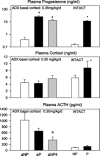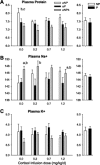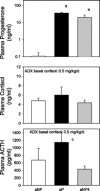Regulation of maternal ACTH in ovine pregnancy: does progesterone play a role?
- PMID: 18697912
- PMCID: PMC4116351
- DOI: 10.1152/ajpendo.90399.2008
Regulation of maternal ACTH in ovine pregnancy: does progesterone play a role?
Abstract
Pregnancy is characterized by increased plasma adrenocorticotropic hormone (ACTH) and cortisol. Studies suggest that progesterone acts as an antagonist at mineralocorticoid receptors. Therefore, we tested the hypothesis that chronic progesterone, produced by treatment of nonpregnant ewes or during pregnancy, will result in increased plasma ACTH relative to the plasma cortisol concentrations. We studied three groups of ewes: ovariectomized nonpregnant, nonpregnant treated with progesterone, and pregnant ewes. In two series of studies, ewes were adrenalectomized and replaced with 0.35 mg x kg(-1) x day(-1) or 0.5 mg x kg(-1) x day(-1) cortisol. In both studies, aldosterone was infused at 3 microg x kg(-1) x day(-1). In the first study, additional infusions of cortisol over 24 h were used to increase daily replacement doses to 0.5, 1, or 1.5 mg x kg(-1) x day(-1), and intact pregnant and nonpregnant ewes were studied with infusions of cortisol at 0, 0.5, and 1 mg x kg(-1) x day(-1). In adrenalectomized ewes chronically replaced to 0.35 mg x kg(-1) x day(-1) cortisol, plasma ACTH concentrations were decreased significantly in the nonpregnant progesterone-treated ewes compared with the ovariectomized nonpregnant ewes. With 0.5 mg x kg(-1) x day(-1) cortisol, plasma ACTH levels were greater in pregnant ewes than in nonpregnant ewes with or without progesterone. Overall plasma ACTH levels at 0.35 mg x kg(-1) x day(-1) were significantly related to the plasma protein concentration, suggesting that the ACTH levels in the hypocorticoid ewes are most closely related to plasma volume. Across all steroid doses, ACTH was positively related to plasma proteins and progesterone, and negatively related to cortisol. We conclude that increased progesterone does not alter the feedback relation of cortisol to ACTH, but may modulate ACTH indirectly through plasma volume.
Figures





Similar articles
-
Pregnancy alters cortisol feedback inhibition of stimulated ACTH: studies in adrenalectomized ewes.Am J Physiol Regul Integr Comp Physiol. 2001 Jun;280(6):R1790-8. doi: 10.1152/ajpregu.2001.280.6.R1790. Am J Physiol Regul Integr Comp Physiol. 2001. PMID: 11353684
-
Differential effects of mineralocorticoid blockade on the hypothalamo-pituitary-adrenal axis in pregnant and nonpregnant ewes.Am J Physiol Endocrinol Metab. 2011 Mar;300(3):E592-9. doi: 10.1152/ajpendo.00560.2010. Epub 2011 Jan 4. Am J Physiol Endocrinol Metab. 2011. PMID: 21205934 Free PMC article.
-
Evidence for reset of regulated cortisol in pregnancy: studies in adrenalectomized ewes.Am J Physiol. 1998 Jan;274(1):R145-51. doi: 10.1152/ajpregu.1998.274.1.R145. Am J Physiol. 1998. PMID: 9458911
-
Inhibition of stimulated and basal ACTH by cortisol during ovine pregnancy.Am J Physiol. 1996 Jul;271(1 Pt 2):R130-6. doi: 10.1152/ajpregu.1996.271.1.R130. Am J Physiol. 1996. PMID: 8760213
-
The normal increase in adrenal secretion during pregnancy contributes to maternal volume expansion and fetal homeostasis.J Soc Gynecol Investig. 2002 Nov-Dec;9(6):362-71. J Soc Gynecol Investig. 2002. PMID: 12445601
References
-
- Bell ME, Wood CE, Keller-Wood M. Influence of reproductive state on pituitary-adrenal activity in the ewe. Dom An Endocrinol 8: 245–254, 1991 - PubMed
-
- Brooks VL, Quesnell RR, Cumbee SR, Bishop VS. Pregnancy attenuates activity of the baroreceptor reflex. Clin Exp Pharmacol Physiol 22: 152–156, 1995 - PubMed
-
- Carey MP, Deterd CH, deKonig J, Helmerhost F, DeKloet ER. The influence of ovarian steroids on hypothalamic-pituitary-adrenal regulation in the female rat. J Endocrinol 144: 311–321, 1995 - PubMed
-
- Carr BR, Parker CR, Madden JD, MacDonald PC, Porter JC. Maternal adrenocorticotropin and cortisol relationships throughout human pregnancy. Am J Obstet Gynecol 139: 416–422, 1981 - PubMed
-
- Darlington DN, Tehrani MJ. Blood flow, vascular resistance, and blood volume after hemorrhage in conscious adrenalectomized rat. J Appl Physiol 83: 1648–1653, 1997 - PubMed
MeSH terms
Substances
Grants and funding
LinkOut - more resources
Full Text Sources

